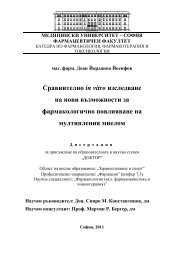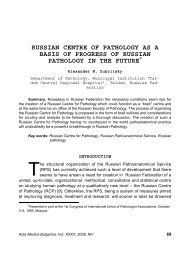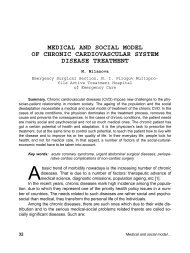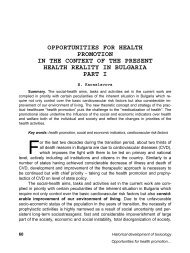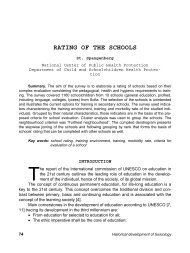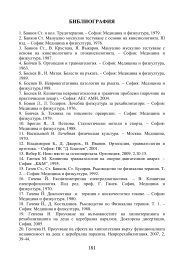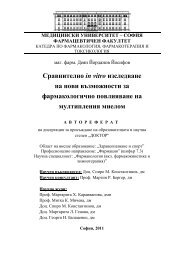Литературен преглед
Литературен преглед
Литературен преглед
Create successful ePaper yourself
Turn your PDF publications into a flip-book with our unique Google optimized e-Paper software.
71. Kirk, S., D. Parker, T. Claridge, et al. (2007). Patient safety culture in primary care:<br />
developing a theoretical framework for practical use. Qual Saf Health Care; 16: p.<br />
313 – 320.<br />
72. Kohn, L. T., J. M. Corrigan, et al., Eds. (1999). To Err is Human: Building a Safer<br />
Health System. Washington, DC, National Academy Press.<br />
73. Kraman, S., G. Hamm. (1999). Risk Management: Extreme Honesty May Be the Best<br />
Policy. Medicine and Public Issue. Volume 131 Issue 12 | Pages 963-967. стр. 66.<br />
74. Kristensen S., P. Bartels. (2007). Patient Safety Culture: assessment instruments. Bohn<br />
Stafleu van Loghum. p.p. 63-76.<br />
75. Lamb, R. (2004). Open disclosure: the only approach to medical error. Qual. Saf.<br />
Health Care 13: 3-5.<br />
76. Law, M., R. Zimmerman et al. (2010). Assessment of Safety Culture Maturity in a<br />
Hospital Setting. Healthcare Quarterly, 13 (Sp) 2010: 110-115.<br />
77. Lawton, R., D. Parker. (2002). Barriers to incident reporting in a healthcare system.<br />
Qual. Saf. Health Care. 11: 15-18.<br />
78. Leape, L. (1994). Error in medicine. The Journal of American Medicine. Volume 272,<br />
number 23, page 1851(7).<br />
79. Leape, L. (2006). Full Disclosure and Apology – An Idea Whose Time has Come.<br />
Physician Executive 32 (2): 16-18.<br />
80. Leape, L. (2007). Why pay for mistakes? www.boston.com (Last accessed on Sept.<br />
7 th , 2007).<br />
81. Leape, L. L. (2002). Reporting of Adverse Events. The New England Journal of<br />
Medecine. Number 20. Volume 347:1633-1638.<br />
82. Leape, L. L., Brennan TA, Laird N, Lawthers AG, Localio AR, Barnes BA, Hebert L,<br />
Newhouse JP, Weiler PC, Hiatt H (1991). ―The nature of adverse events in<br />
hospitalized patients. Results of the Harvard Medical Practice Study II.‖ New England<br />
Journal of Medicine 324(6): 377-384.<br />
83. Leape, L.L., D. Berwick. (2000). Safe health care: are we up to it? BMJ 2000;320;725-<br />
726.<br />
84. Leape, L. L. (2000). Institute of Medicine. Medical Error Figures Are Not<br />
Exaggerated. JAMA: 284(1): 95-97.<br />
85. Leape, L.L., D. Berwick. (1999). Reducing errors in medicine. BMJ 1999;319;136-<br />
137<br />
86. Longo, D. et al. (20050. The Long Road to Patient Safety. JAMA, December 14,<br />
2005—Vol 294, No. 22. pp 2858 – 2865. (Downloaded from www.jama.com on<br />
February 18, 2008)<br />
87. Lwanga, S. K., S. Lemeshow. (1995). Sample size determination in health studies.<br />
WHO Geneva.<br />
88. Marx, D. (2001). Patient Safety and the ―Just Culture‖: A Primer for Health Care<br />
Executives. http://www.mers-tm.org/support/Marx_Primer.pdf (Last accessed on<br />
March, 17 th , 2006).<br />
159




